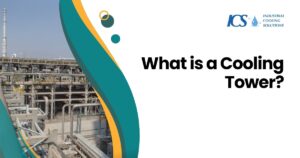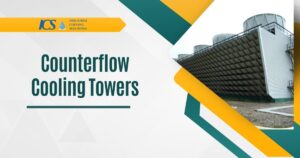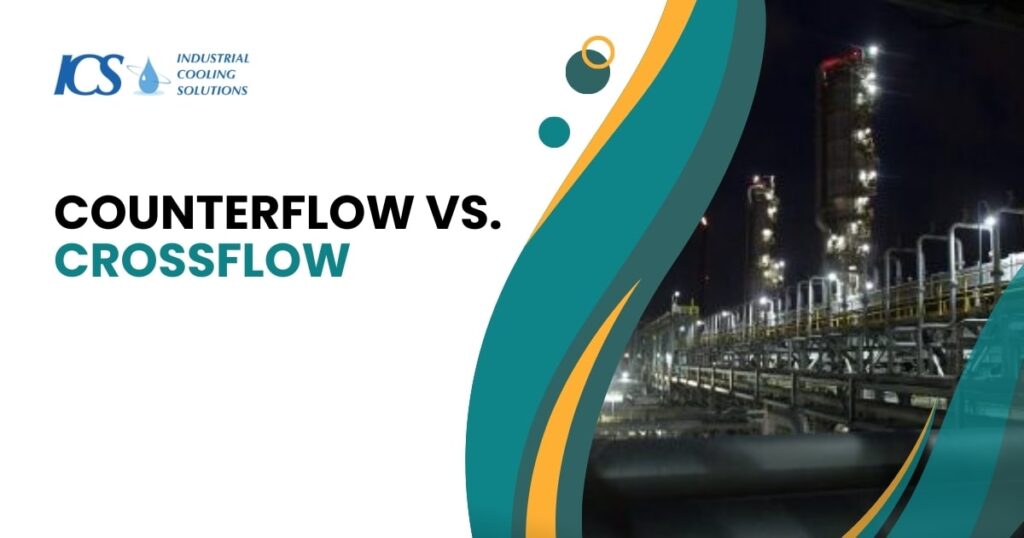Cooling towers are manufactured in many different configurations and sizes to match a wide range of applications across many different industries. Understanding that different configurations may have different advantages and disadvantages is important for you to be able to decide which one will be most efficient and cost-effective for your company.
In this blog, we’re going to discuss the difference between a crossflow and a counterflow cooling tower and how it works as an air-cooled heat exchanger in large industries.
What is a Cooling Tower?

With a crossflow tower, hot water flows downward from a distribution basin while air flows horizontally. They are filled with splash, hybrid, or film-type fill and can be applied when the water has higher suspended particles when the plan area is tight or just per owner preference.
At Industrial Cooling Solutions (ICS), we offer crossflow towers in concrete, FRP, and wood structures as well as splash fill, film fill, and low-fouling fill materials. ICS cooling towers are built to withstand the most demanding of situations and provide the most cost-effective solution for you.
Benefits of Crossflow Cooling Tower
- High Performance and Energy Efficiency
- Low Maintenance
- High tolerance for particulates, oils, and contamination in the water. Well suited for Fertilizer, Steel, Food Processing, or other industries that have high particulate loads or other water contaminators.
- Crossflow tower has low noise.
- Optimized Power Consumption
- Easy maintenance access inside the tower
Disadvantages of Crossflow Cooling Towers
- There is a higher potential for re-circulation due to the air inlets being open to the hot water deck.
- Water noise is harder to control due to the large open inlet areas.
- Low water loading per M2
Counterflow Cooling Towers

A counterflow tower mechanism is a newer and quite popular design in which water flows vertically through the fill or packing from the top while air enters the bottom of the tower and flows upwards. In counter flow towers, there is an induced draught fan that is attached to the motor.
This fan pulls in dry air to draft it upward, resulting in air that is exhausted faster than it is pulled in. In turn, you’ll see lower pressure and re-circulation by a cross-flow cooling tower.
Benefits of Counterflow Towers
- Low Power Consumption
- Low Fouling Film, Hybrid, or Splash fills
- Plume Abated Systems
- The Counterflow Cooling Tower has a Low Pumphead
- High Performance with Minimal Maintenance
- Optimized Footprint
- FRP Wood or Concrete Structures
Disadvantages of Counter Flow Cooling Towers
- Low Water Loading per Square Meter
- Higher Initial Installing Costs
- Accessing and Maintaining the Internal Cooling Tower Components are Complicated
- Challenging to Control Water Noise
- Limited access and space inside the cooling tower
Which one should you choose?
The type of cooling tower you choose will depend entirely on the industry, physical size, overall efficiency, and application. What works for one company may not be effective for another. Another factor that is taken into consideration is the typical climate and conditions on your site.
ICS’s cooling tower experts can assist you in selecting the correct tower configuration for your industry, site, and project needs. Contact us to learn more about which type of cooling tower is right for your company according to your site conditions and needs.
Conclusion
The cooling tower interacts and works for maximum heat transfer. The basic working principle of crossflow and counterflow cooling towers is the same: hot water comes to the cooling tower by the water channeling, and the nozzle spray system ensures the even distribution of quality water over the fill media to enhance the surface area of the process water.
Due to the airflow, air moving system, and evaporation process, water temperature gradually decreases and gathers at the bottom of the cold water basin, from where cold water distributes towards the industrial processes.

